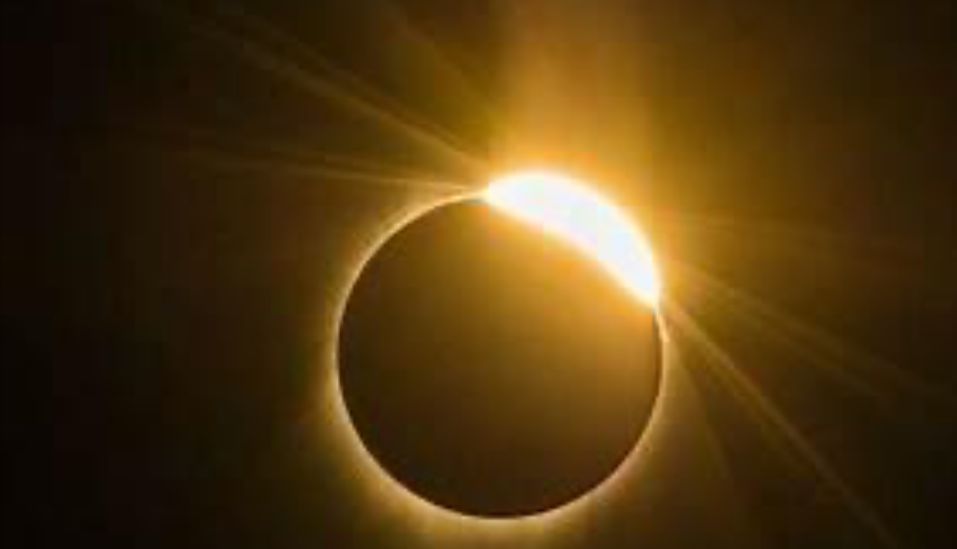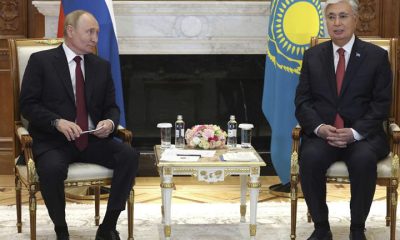Trending
United States and Mexico currently experiencing Total solar eclipse as it builds up in the two Countries.

On Monday, April 8, 2024, a total solar eclipse will cross North America, passing over Mexico, the United States, and Canada, the National Aeronautics and Space Administration has revealed.
A total solar eclipse happens when the moon passes between the sun and earth, completely blocking the face of the sun. The sky will darken as if it were dawn or dusk.
While disclosing the information on Sunday, NASA said, “Safety is the number one priority when viewing a total solar eclipse. Be sure you’re familiar with when you need to wear specialised eye protection designed for solar viewing by reviewing these safety guidelines.”
The agency said people could watch live with them as the total solar eclipse “moves across North America on April 8, 2024, traveling through Mexico, across the United States from Texas to Maine, and out across Canada’s Atlantic coast.”
Except during the brief total phase of a total solar eclipse, when the moon completely blocks the sun’s bright face, it is not safe to look directly at the sun without specialised eye protection for solar viewing, it says on safety.
Viewing any part of the bright sun through a camera lens, binoculars, or a telescope without a special-purpose solar filter secured over the front of the optics will instantly cause severe eye injury, it further warns.
“When watching the partial phases of the solar eclipse directly with your eyes, which happens before and after totality, you must look through safe solar viewing glasses (‘eclipse glasses’) or a safe handheld solar viewer at all times. You can also use an indirect viewing method, such as a pinhole projector,” NASA added.
The agency noted that the solar eclipse would be different from the last one experienced in 2017.
In 2017, an estimated 215 million US adults (88% of US adults) viewed the solar eclipse, either directly or electronically. They experienced the moon pass in front of the Sun, blocking part or all of our closest star’s bright face. The eclipse in 2024 could be even more exciting due to differences in the path, timing, and scientific research, NASA revealed on its website.
Wider, more populated path
According to the agency, the path of totality – where viewers can see the moon totally block the sun, revealing the star’s outer atmosphere, called the corona – is much wider during the upcoming total solar eclipse than it was during the eclipse in 2017.
As the moon orbits earth, its distance from our planet varies, NASA said, noting that during the 2017 total solar eclipse, the moon was a little bit farther away from earth than it would be during the upcoming total solar eclipse, causing the path of that eclipse to be a little skinnier. In 2017, the path ranged from about 62 to 71 miles wide. During the Monday eclipse, the path over North America will range between 108 and 122 miles wide – meaning at any given moment, this eclipse covers more ground.
The 2024 eclipse path will also pass over more cities and densely populated areas than the 2017 path did. This will make it easier for more people to see totality.
“An estimated 31.6 million people live in the path of totality this year, compared to 12 million in 2017. An additional 150 million people live within 200 miles of the path of totality,” the organisation disclosed.
Trending
The man who tackled a gunman to the floor and saved people from getting sh0t at Bondi Beach in Australia has been identified as Ahmed al Ahmed.

The man who tackled a gunman to the floor and saved people from getting sh0t at Bondi Beach in Australia has been identified as Ahmed al Ahmed.
He was shot during the incident and is currently recuperating in a hospital.
Meanwhile the two gunmen who k!lled over 9 people during the attack were neutralised.
NB: This page does not support violence and this is just a news report.
https://www.instagram.com/reel/DSQXFGajEFV/?igsh=M295eGdiNGVtbHBn
🎥 @7newsaustralia
Trending
Female Student Missing For 8 Days Found Chilling At Boyfriend’s House

A fresh controversy erupted online after a female student, missing for eight days, was found at her boyfriend’s house.
Details of the incident were shared by a classmate of the lady, identified as @folaaaa on X (formerly Twitter).
According to @folaaaa, her classmate’s parents are of age, and the father disclosed that he is currently 70 years old.
Prior to her being found, her last WhatsApp activity was on Monday, December 8, 2025.
Read Tweet Below…..
My coursemate was reported missing by her parents yesterday. They said they could not reach her for like 8 days. We did our research she was last seen online on Monday. They sha did perfect investigation with the oga olopa and they found out she was with her man”.
Meanwhile, the tweet which has garned over 400,000 views has been flooded with reactions from X users.
Dam Dam stated, “Dem suppose arrest Her and her man. Make dem sleep inside cell for a week. Imagine giving your parents so much headache and eventually you are with a man,at least call them and let them know you are safe wherever you are”.
PP the art, “The number of people that had shared and reshared “missing girl” on my WhatsApp cl was crazy. my friend was telling me this just now and i was so shocked”.
Jimmy, “Same thing happened in my department while i was in year 1,fliers were made they even interrogated her male friends.these went on for the whole of the semester only to find out she reads the class group messages and sees the missing fliers. She then later said she’s with her man”.
Bhetty, “She went to see a man and she didn’t take her parents’ call?Make she sleep cell for 3 days”.
See below…..

Trending
“It took me getting married and giving birth to realise marriage benefits men more” — Woman shares emotional thoughts

A woman has stirred serious conversations online after opening up about how marriage and motherhood changed her perspective on life.
In a heartfelt reflection, she said it was only after getting married and giving birth that she began questioning who marriage truly benefits.
According to her, women often carry the heavier load — emotionally, physically, and mentally.
She explained that marriage can make women feel like tools, responsible for cooking, cleaning, caring for the home, and even contributing financially, while still bearing the full weight of pregnancy, childbirth, and childcare.
She questioned why something described as a “blessing” should come with so much pain, stress, sleepless nights, and emotional strain for women.
In her words, childbirth comes with intense pain, followed by years of responsibility that largely fall on the woman, while many men continue life almost unchanged.
She admitted she never strongly pushed for marriage herself and only went along with it after family pressure. It was the lived experience — not theory — that opened her eyes.
While she made it clear that she loves her son deeply and finds joy in him, she said motherhood also forced her to confront uncomfortable truths about expectations placed on women.
📹: TT/mummychika1
https://www.instagram.com/reel/DSP0XSnjAvd/?igsh=MTd3ZzdlbWI0dHV1Nw==
-
Business1 year ago
US court acquits Air Peace boss, slams Mayfield $4000 fine
-

 Trending1 year ago
Trending1 year agoNYA demands release of ‘abducted’ Imo chairman, preaches good governance
-

 Politics1 year ago
Politics1 year agoMexico’s new president causes concern just weeks before the US elections
-

 Politics1 year ago
Politics1 year agoPutin invites 20 world leaders
-

 Politics1 year ago
Politics1 year agoRussia bans imports of agro-products from Kazakhstan after refusal to join BRICS
-
Entertainment1 year ago
Bobrisky falls ill in police custody, rushed to hospital
-
Entertainment1 year ago
Bobrisky transferred from Immigration to FCID, spends night behind bars
-
Education1 year ago
GOVERNOR FUBARA APPOINTS COUNCIL MEMBERS FOR KEN SARO-WIWA POLYTECHNIC BORI













